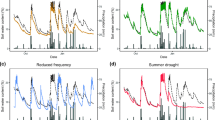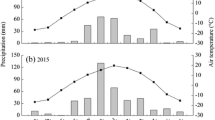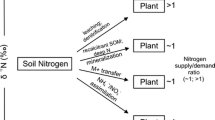Abstract
This study was designed to identify potential effects of elevated CO2 on belowground respiration (the sum of root and heterotrophic respiration) in field and microcosm ecosystems and on the annual carbon budget. We made three sets of respiration measurements in two CO2 treatments, i.e., (1) monthly in the sandstone grassland and in microcosms from November 1993 to June 1994; (2) at the annual peak of live biomass (March and April) in the serpentine and sandstone grasslands in 1993 and 1994; and (3) at peak biomass in the microcosms with monocultures of seven species in 1993. To help understand ecosystem carbon cycling, we also made supplementary measurements of belowground respiration monthly in sandstone and serpentine grasslands located within 500 m of the CO2 experiment site. The seasonal average respiration rate in the sandstone grassland was 2.12 μmol m-2 s-1 in elevated CO2, which was 42% higher than the 1.49 μmol m-2 s-1 measured in ambient CO2 (P=0.007). Studies of seven individual species in the microcosms indicated that respiration was positively correlated with plant biomass and increased, on average, by 70% with CO2. Monthly measurements revealed a strong seasonality in belowground respiration, being low (0–0.5 μmol CO2 m-2 s-1 in the two grasslands adjacent to the CO2 site) in the summer dry season and high (2–4 μmol CO2 m-2 s-1 in the sandstone grassland and 2–7 μmol CO2 m-2 s-1 in the microcosms) during the growing season from the onset of fall rains in November to early spring in April and May. Estimated annual carbon effluxes from the soil were 323 and 440 g C m-2 year-1 for the sandstone grasslands in ambient and elevated CO2. That CO2-stimulated increase in annual soil carbon efflux is more than twice as big as the increase in aboveground net primary productivity (NPPa) and approximately 60% of NPPa in this grassland in the current CO2 environment. The results of this study suggest that below-ground respiration can dissipate most of the increase in photosynthesis stimulated by elevated CO2.
Similar content being viewed by others
References
Bowden RD, Nadelhoffer KJ, Boone RD, Melillo JM, Garrison JB (1993) Contributions of aboveground litter, belowground litter, and root respiration to total soil respiration in a temperate mixed hardwood forest. Can J For Res 23: 1402–1407
Bremner JM, Mulvaney CS (1982) Nitrogen-total. In: Page AL (ed) Methods of soil analysis. II. American Society of Agronomy, Madison, Wis, pp 595–624
Cheng W, Coleman DC, Carroll CR, Hoffman CA (1994) Investigating short-term carbon flows in the rhizospheres of different plant species, using isotopic trapping. Agron J 86: 782–788
Chiariello NR (1989) Phenology of California grasslands. In: Huenneke LF, Mooney HA (eds) Grassland structure and function: California annual grassland. Kluver, Dordrecht, pp 47–58
Chu CC, Field CB, Mooney HA (1996) Effects of CO2 and nutrient amendment on tissue quality of two California annuals. Oecologia (in press)
Drake BG, Peresta GJ (1993) Open-top chambers for studies of the long-term effects of elevated atmospheric CO2 and carbon balance on wetland and forest ecosystem processes. In: Schulze ED, Mooney HA (eds) Design and execution of experiments on CO2 enrichment. Commission of the Europeam Communities, Luxembourg, pp 273–289
Dugas WA (1993) Micrometeorological and chamber measurements CO2 flux from bare soil. Agric For Meteorol 67: 115–128
Field CB, Jackson RB, Mooney HA (1995) Stomatal responses to increased CO2: implications from plant to global scale. Plant Cell Environ 1214–1225
Field CB, Chapin FS III, Chiariello NR, Holland EA, Mooney HA (1996) The Jasper Ridge CO2 experiment: design and motivation. In: Koch GW, Mooney HA (eds) Carbon dioxide and terrestrial ecosystems. Academic Press, San Diego, CA, pp. 121–145
Grahammer K, Jawson MD, Skopp J (1991) Day and night soil respiration from a grassland. Soil Biol Biochem 23: 77–81
Grulke NE, Riechers GH, Oechel WC, Hjelm U, Jasger C (1990) Carbon balance in tussock tundra under ambient and elevated atmospheric CO2. Oecologia 83: 485–494
Gunderson CA, Wullschleger SD (1994) Photosynthetic acclimation in trees to rising atmospheric CO2: a broader perspective. Photosynth Res 39: 369–388
Hanson PJ, Wullschleger SD, Bohlman SA, Todd DE (1993) Seasonal and topographic patterns of forest floor CO2 efflux from an upland oak forest. Tree Physiol 13: 1–15
Hickman JC (1993) The Jepson Manual: higher plants of California. University of California Press, Berkeley, Calif
Hobbs RJ, Mooney HA (1985) Community and population dynamics of serPentine grassland annuals in relation to gopher disturbance. Oecologia 67: 342–351
Hungate BA, Jackson RB, Field CB, Chapin FS (1996) Field CO2 enrichment experiments lack statistical power to detect changes in soil carbon cycling. Plant Soil (in press)
Jackson RB, Sala OE, Field CB, Mooney HA (1994) CO2 alters water use, carbon gain, and yield for a dominant species in a natural grassland. Oecologia 98: 257–262
Jackson RB, Luo Y, Cardon ZG, Sala OE, Field CB, Mooney HA (1995) Photosynthesis, growth, and density for the dominant species in a CO2-enriched grassland. J Biogeogr 22: 221–225
Johnson DW, Geisinger DR, Walker RF, Newman J, Vose JR, Elliot KJ, Ball JT (1994) Soil pCO2, soil respiration, and root activity in CO2-fumigated and nitrogen-fertilized ponderosa pine. Plant Soil 165: 129–138
Kashiwagi J (1985) Soil map of the Jasper Ridge Biological Preserve. Soil Conservation Service Map. Jasper Ridge Biological Preserve Publication, Stanford, Calif
Kim J, Verma SB (1992) Soil surface CO2 flux in a Minnesota peatland. Biogeochemistry 18: 37–51
Lee HSJ, Barton CVM (1993) Comparative studies on elevated CO2 using open-top chambers, tree chambers and branch bags. In: Schulze ED, Mooney HA (eds) Design and execution of experiments on CO2 enrichment. Commission of the Europeam Communities, Luxembourg, pp 239–259
Luo Y, Field CB, Mooney HA (1994) Predicting responses of photosynthesis and root fraction to elevated CO2: interactions among carbon, nitrogen, and growth. Plant Cell Environ 17: 1195–1204
Luo Y, Chen JL, Reynolds JF, Field CB, Mooney HA (1996) Elevated CO2 altered plant carbon balance in California grasslands: modeling studies with a generic plant simulator (GePSi). Ecol Model (in press)
McNaughton SJ (1968) Structure and function of California grasslands. Ecology 49: 962–972
Monteith JL, Unsworth MH (1990) Principles of environmental physics, 2nd edn. Arnold, London
Nakayama FS, Huluka G, Kimball BA, Lewin KF, Nagy J, Hendrey GR (1994) Soil carbon dioxide fluxes in natural and CO2 enriched systems. Agric For Meteorol 70: 131–140
Norby RJ, O'Neill EG, Hood WG, Luxmoore RJ (1987) Carbon allocation, root exudation and mycorrhizal colonization of Pinus echinata seedlings grown under CO2 enrichment. Tree Physiol 3: 203–210
Norman JM, Garcia R, Verma SB (1992) Soil surface CO2 fluxes and the carbon budget of a grassland. J Geophys Res 97: 18845–18853
Oberbauer SF, Oechel WC, Riechers GH (1986) Soil respiration of Alaskan tundra at elevated atmospheric carbon dioxide concentrations. Plant Soil 96: 145–148
Prior SA, Rogers HH, Runion GB, Mauney JR (1994) Effects of free-air CO2 enrichment on cotton root growth. Agric For Meteorol 70: 69–86
Raich JW, Nadelhoffer KJ (1989) Belowground carbon allocation in forest ecosystems: global trends. Ecology 70: 1346–1354
Raich JW, Schlesinger WH (1992) The global carbon dioxide flux in soil respiration and its relationship to vegetation and climate. Tellus 44B: 81–99
Rogers HH, Prior SA, O'Neill EG (1993) Cotton root and rhizosphere responses to free-air CO2 enrichment. In: Hendrey GR (ed) FACE: free-air CO2 enrichment for plant research in the field. CRC Press, Boca Raton, Fla, pp 251–263
Rogers HH, Runion GB, Krupa SV (1994) Plant responses to atmospheric CO2 enrichment with emphasis on roots and the rhizosphere. Environ Pollut 83: 155–189
Singh JS, Gupta SR (1977) Plant decomposition and soil respiration in terrestrial ecosystems. Bot Rev 43: 449–528
Strain BR, Cure JD (1985) Direct effects of increasing carbon dioxide on vegetation. United States Department of Energy, DOE/ER-0238, Washington, DC
Tissue DT, Oechel WC (1987) Response of Eriophorum vaginatum to elevated CO2 and temperature in the Alaskan tussock tundra. Ecology 68: 401–410
Vose JM, Elliot KJ, Johnson DW, Walker RF, Johnson MG, Tingey DT (1995) Effects of elevated CO2 and N fertilization on soil respiration from ponderosa pine (Pinus ponderosa) in opentop chambers. Can J For Res 25: 1243–1251
Wood CW, Torbert HA, Rogers HH, Runion GB, Prior SA (1994) Free-air CO2 enrichment effects on soil carbon and nitrogen. Agric For Meteorol 70: 103–116
Author information
Authors and Affiliations
Corresponding author
Additional information
CIWDPB Publication # 1271
Rights and permissions
About this article
Cite this article
Luo, Y., Jackson, R.B., Field, C.B. et al. Elevated CO2 increases belowground respiration in California grasslands. Oecologia 108, 130–137 (1996). https://doi.org/10.1007/BF00333224
Received:
Accepted:
Issue Date:
DOI: https://doi.org/10.1007/BF00333224




